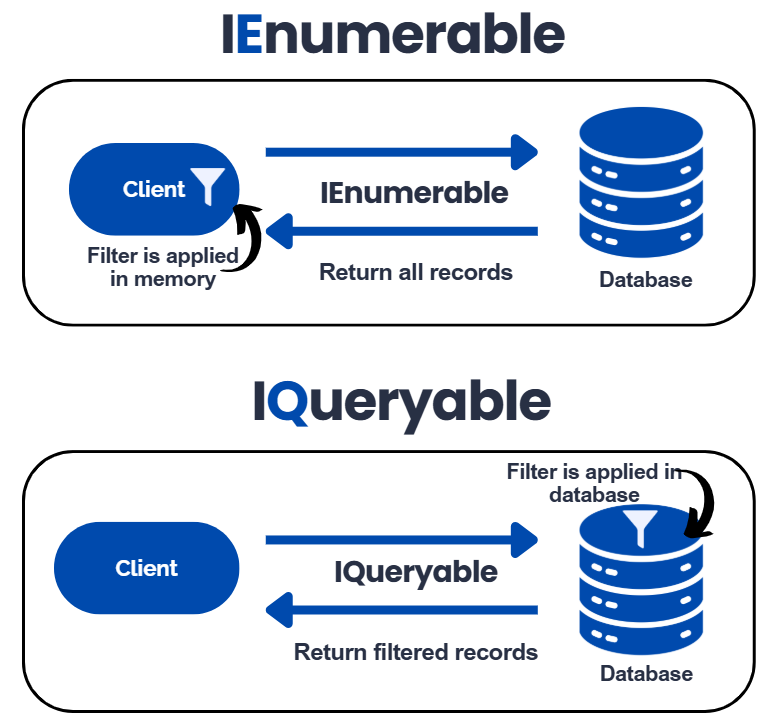IEnumerable vs IQueryable: Understanding the Difference
Boost Application Performance by Knowing When to Use IEnumerable or IQueryable
In modern .NET development, efficiently querying and manipulating data is crucial. When working with collections or databases, developers often encounter IEnumerable and IQueryable. Both allow you to query data, but they behave very differently under the hood. Choosing the right one can significantly impact performance and memory usage.
In this article, we'll break down the differences, use cases, and provide practical C# examples.
📦 What is IEnumerable?
IEnumerable is an interface that represents a sequence of objects that can be iterated over. It is part of the System.Collections namespace.
Key Points:
Works in-memory (after data is loaded into memory).
Query execution is deferred only for LINQ operators like
WhereorSelect.Cannot translate queries to SQL when working with Entity Framework or LINQ to SQL.
Ideal for querying collections in memory like
List<T>orArray.
Example:
using System;
using System.Collections.Generic;
using System.Linq;
class Program
{
static void Main()
{
List<int> numbers = new List<int> { 1, 2, 3, 4, 5, 6 };
IEnumerable<int> evenNumbers = numbers.Where(n => n % 2 == 0);
foreach (var num in evenNumbers)
{
Console.WriteLine(num);
}
}
}Here, the filtering happens in memory, after the numbers list is loaded.
🌐 What is IQueryable?
IQueryable extends IEnumerable and is designed for remote data querying (like databases). It is part of the System.Linq namespace.
Key Points:
Works with deferred execution.
Can translate queries into a query language like SQL when using Entity Framework or LINQ to SQL.
Allows filtering, sorting, and joining data at the database level rather than in memory.
Ideal for querying large datasets efficiently.
Example:
using System;
using System.Linq;
using Microsoft.EntityFrameworkCore;
class Program
{
static void Main()
{
using var context = new AppDbContext();
IQueryable<User> adultUsers = context.Users
.Where(u => u.Age >= 18);
foreach (var user in adultUsers)
{
Console.WriteLine($"{user.Name} - {user.Age}");
}
}
}Here, the WHERE clause is executed on the database server, reducing memory usage and improving performance.
⚖️ Key Differences Between IEnumerable and IQueryable
Namespace:
IEnumerable → System.Collections
IQueryable → System.Linq
Execution:
IEnumerable → In-memory
IQueryable → Database (remote)
Query Translation:
IEnumerable → No SQL translation
IQueryable → Supports SQL translation
Deferred Execution:
IEnumerable → Yes
IQueryable → Yes
Use Case:
IEnumerable → Small collections in memory
IQueryable → Large datasets or database queries
Performance:
IEnumerable → Slower for large datasets
IQueryable → Faster for large datasets due to server-side execution
💡When to Use Which?
IEnumerable: Use it when working with in-memory collections, like
List<T>,Array, or after data is already fetched from the database.IQueryable: Use it when querying databases, remote services, or large datasets to leverage server-side filtering and performance.
Pro Tip: Avoid calling .ToList() too early on an IQueryable, as it forces in-memory evaluation and negates the performance benefits.
🛠️ Practical Scenario
Suppose you have a database with millions of users. You want to get users older than 30.
Using IEnumerable would load all users into memory first and then filter them, consuming a lot of memory.
Using IQueryable will generate SQL like
SELECT * FROM Users WHERE Age > 30and fetch only the necessary data.
✅ Summary
IEnumerable: Best for in-memory operations, small datasets, simpler queries.
IQueryable: Best for remote queries, large datasets, and performance-sensitive operations.
Choosing the right interface can make your application more efficient, scalable, and maintainable.
💡 Try it out: Next time you query a database with Entity Framework, test the difference between IEnumerable and IQueryable. You’ll notice significant performance differences when working with large data.
I hope you found this guide helpful and informative.
Thanks for reading!
If you enjoyed this article, feel free to share it and follow me for more practical, developer-friendly content like this.


